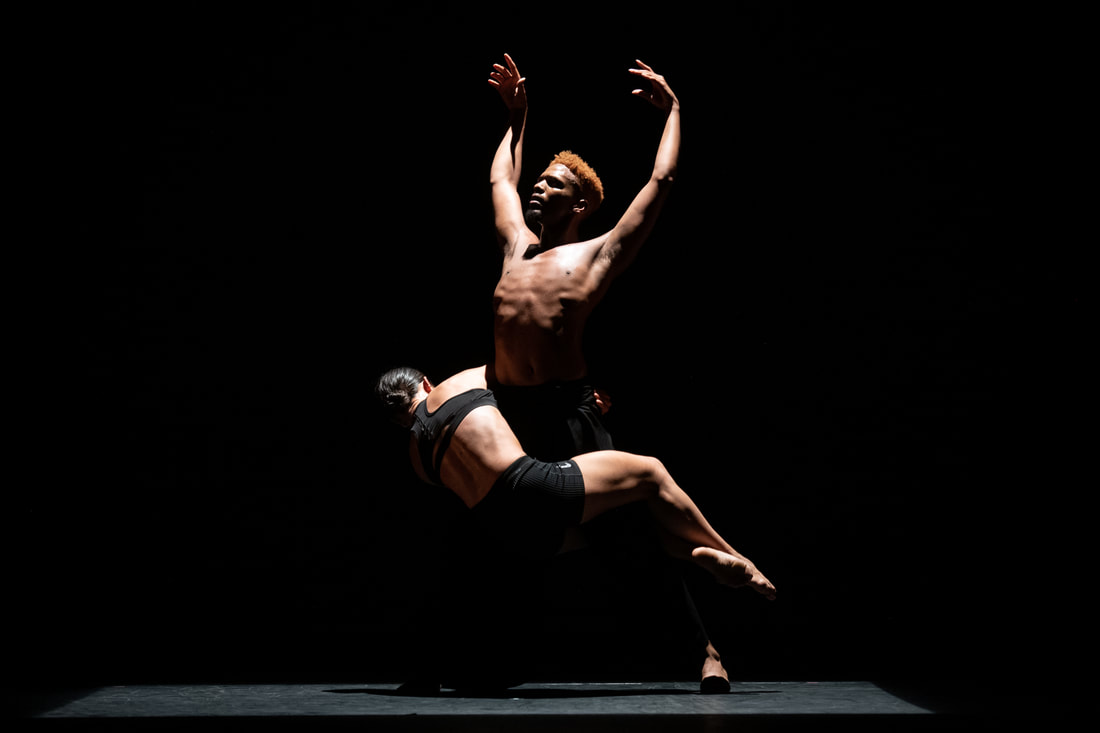|
Corey Boatner and Yoojung Hahm perform in Cleo Parker Robinson Dance Ensemble in "Catharsis." (Photo by Christopher Duggan) A lot can change in 50 years – and that is certainly the case with Cleo Parker Robinson Dance Ensemble.
Performing this week on Jacob’s Pillow main stage, the Denver-based contemporary dance troupe is offering a full scope of its half-century with works dating back to its earliest days -- including a piece by Katherine Dunham and its founder and Artistic Director Cleo Parker Robinson. But it is the newer works, specifically two from 2017, where the appealing and stirring artistry of this mainly African-American company can be found. Donald McKayle’s “Crossing the Rubion: Passing the Point of No Return” and Garfield Lemonius’ “Cartharsis” are stunners – with gut-wrenching duets at their heart – that I promise one would want to see again and again. Both seed their power in the group that elicit images of humanity’s struggle – McKayle in expressing the fear and anxiety felt by refugee and Lemonius, the need for a mental health release from the world’s fraught with ever-mounting pressures. McKayle, a recognized choreographic master, captured the plight of those forced to leave their home because of war, famine and natural disaster in “Crossing the Rubicon.” To music by Anoushka Shankar, a dozen dancers flee. At first, it’s a slow bedraggled and orderly effort. Then later on, their patterns shift to a full-on reckless exodus. Cast in earth-tone shades, they look dusty, tired, but determined in their flight. The central duet with Tyveze Littlejohn and Yoojung Hahm was tentative, but also signaled a surrender. As they rejoin the crowd onstage and become separated, one also felt the pain of lost loved ones. Hahm was also a featured player in “Catharsis,” this time with Corey Boatner. However, instead of connection, in this duet she become, literally, a thing that clings, which he struggles to shed. As he reached out for escape, Boatner’s honesty lured the audience in and thus we all went on the path to deliverance with him. Even more impressive was the ensemble as a whole. Moving to an eloquent music selection from David Lang, Ezio Basso and Arvo Park, the dancers performed with abandon, evoking a flash of ecstasy. Unfortunately, the older pieces on the bill felt dated, including “Salome Daughter’s,” by Nejla Yatkin. The 1998 dance was the evening’s final work for seven women that underscored female repression. While predictable, I did like the piece’s message – never underestimate a woman. Dunham’s piece, the opener, was a jazzy ode to Scott Joplin while Robinson’s was a nod to her church-going youth. I could have lived without both – especially Robinson’s which seemed like an unfortunate spin-off of Alvin Ailey’s “Revelations.” I mean no disrespect to any of the choreographers – especially Dunham who is so important in the history of Black dance in the Americas. But McKayle and Lemonius tapped into something deeper and that is one reason why Cleo Parker Robinson Dance Ensemble could and should thrive for another 50 years.
0 Comments
Leave a Reply. |
Wendy
|

 RSS Feed
RSS Feed
